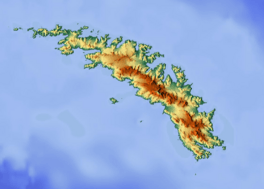Harker Glacier facts for kids
Quick facts for kids Harker Glacier |
|
|---|---|

South Georgia: Cumberland Bay; Thatcher Peninsula with King Edward Cove (Grytviken); Allardyce Range with the summit Mt. Paget (NASA imagery)
|
|
| Location | South Georgia |
| Coordinates | 54°22′0.12″S 36°31′59.88″W / 54.3667000°S 36.5333000°W |
| Thickness | unknown |
| Terminus | Cumberland Bay |
| Status | stable / advancing |
Harker Glacier is a large glacier located on South Georgia Island. This island is in the southern Atlantic Ocean. A glacier is like a huge, slow-moving river of ice. Harker Glacier is a "tidewater glacier," meaning it flows directly into the ocean.
Contents
What is Harker Glacier?
Harker Glacier is a big mass of ice that moves slowly. It flows from the Allardyce Range mountains towards the north. This glacier ends in Moraine Fjord, which is part of Cumberland Bay. This bay is located south of Grytviken, the main town on South Georgia Island.
How does Harker Glacier affect the bay?
Because Harker Glacier is a tidewater glacier, it drops icebergs into the bay. These icebergs break off from the glacier's front. This process is called "calving." It's a natural way for glaciers to lose ice.
The History of Harker Glacier's Name
Harker Glacier has had two different names over time. It was first explored and mapped by scientists.
Who first mapped the glacier?
The Swedish Antarctic Expedition mapped this glacier between 1901 and 1904. They first named it De Geer Glacier. This name honored Gerard De Geer, a Swedish geologist. Geologists study the Earth's rocks and landforms. De Geer was known for his work on how land changes over time.
Why was the name changed?
In 1912, another geologist named David Ferguson remapped the area. He decided to rename the glacier. The new name became Harker Glacier. This was to honor Alfred Harker. He was an English geologist who studied rocks in detail. His work focused on how rocks are formed and what they are made of.
How has the glacier changed over time?
Scientists have observed Harker Glacier for many years. They want to understand if it is growing or shrinking.
Is the glacier stable or changing?
Since the 1970s, Harker Glacier has not changed much. It has stayed about the same size. However, it is currently larger than it was in 1914. We know this because of old photographs. Frank Hurley, a famous photographer, took pictures of the glacier in 1914. Comparing those photos to today's images shows that the glacier has advanced, meaning it has moved further forward into the bay.
See also
 In Spanish: Glaciar Harker para niños
In Spanish: Glaciar Harker para niños


